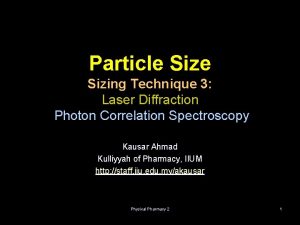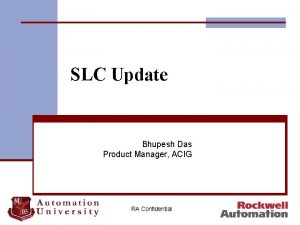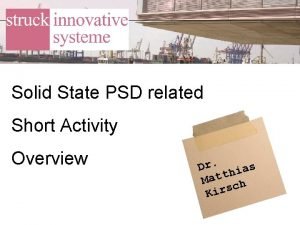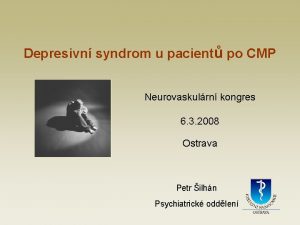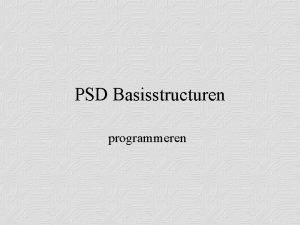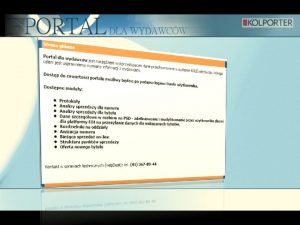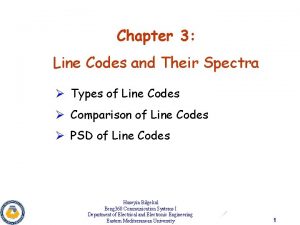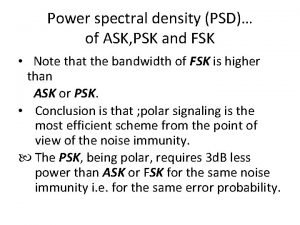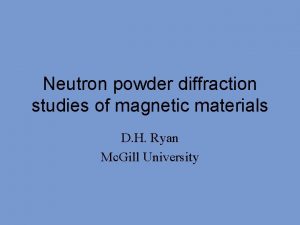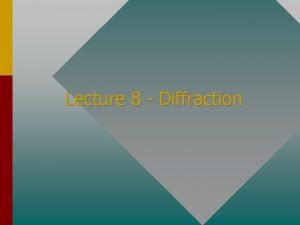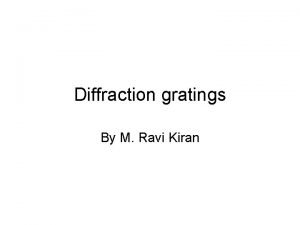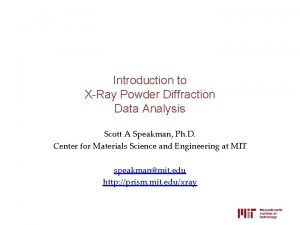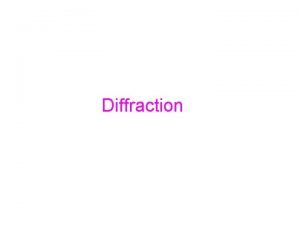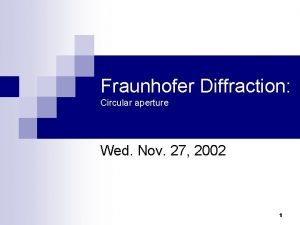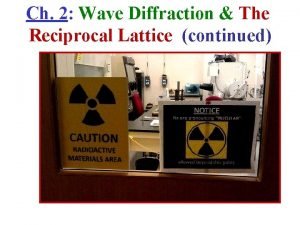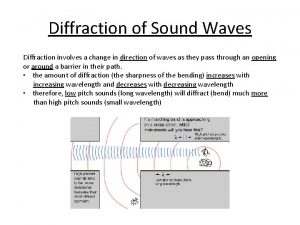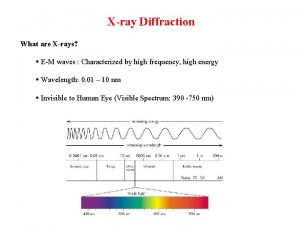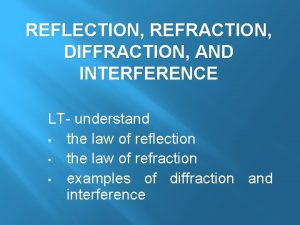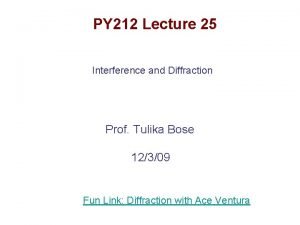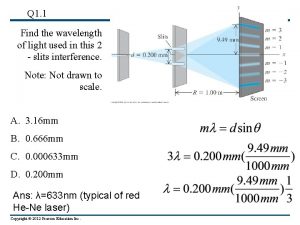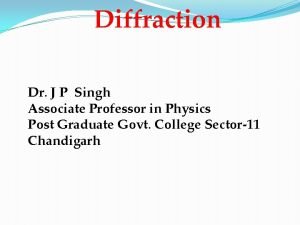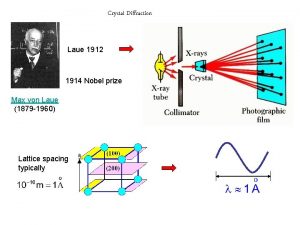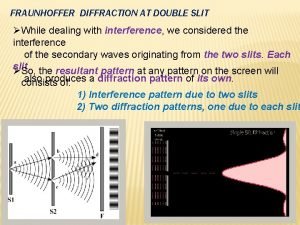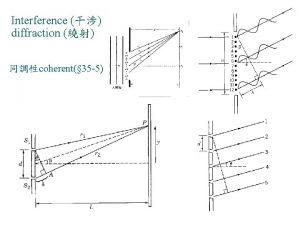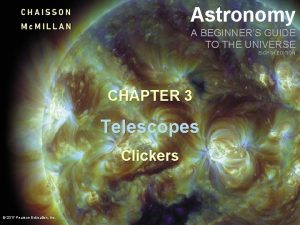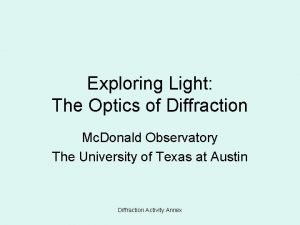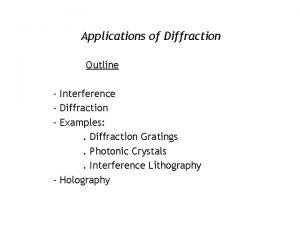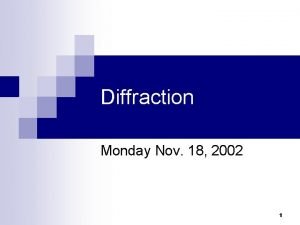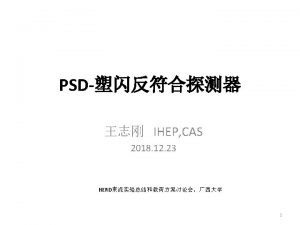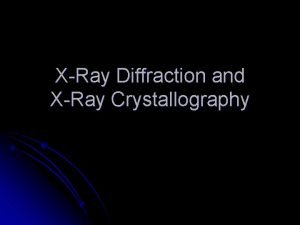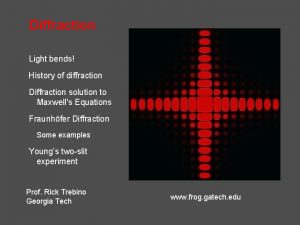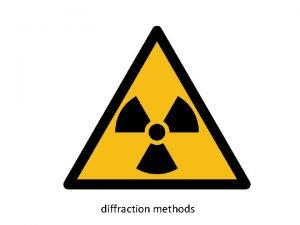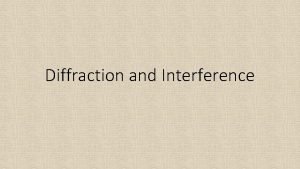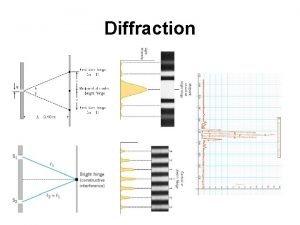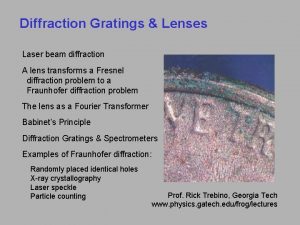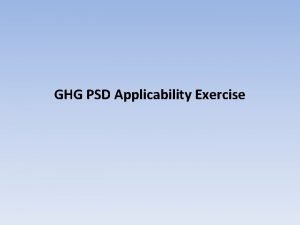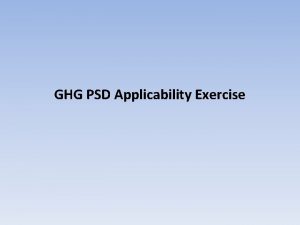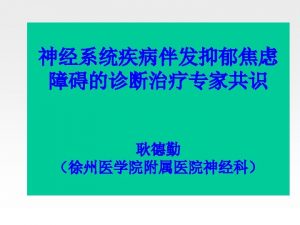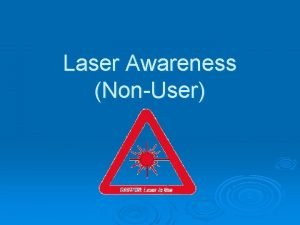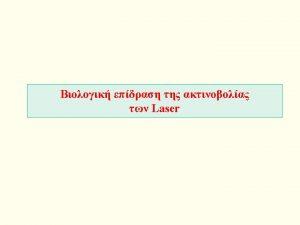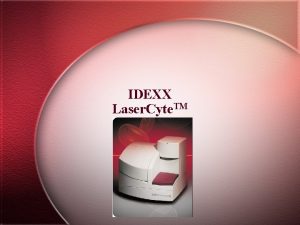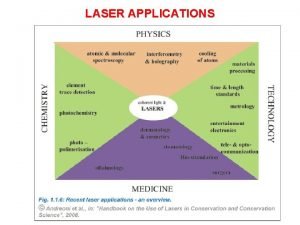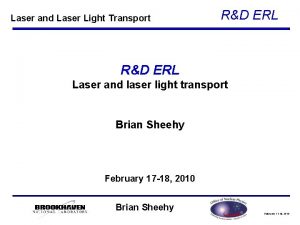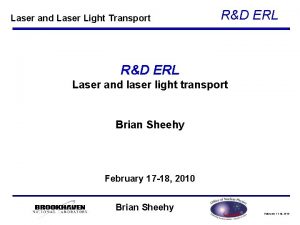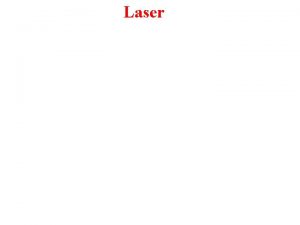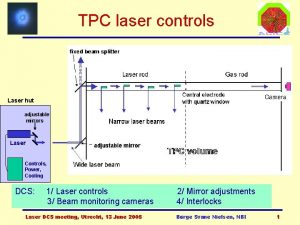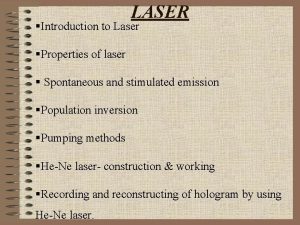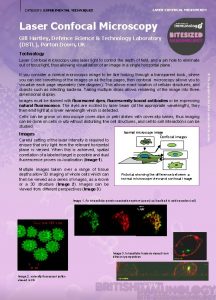Techniques for Determining PSD of PM Laser Diffraction




































- Slides: 36

Techniques for Determining PSD of PM: Laser Diffraction vs. Electrical Sensing Zone A 242 nd ACS National Meeting Presentation: Paper ID 18440 Z. Cao 1, M. Buser 2, D. Whitelock 3, L. Wang-Li*1, Y. Zhang 4, C. B. Parnell 5 1 NCSU, 2 OSU, 3 USDA-ARS, 4 UIUC, 5 TAMU

Introduction: • PM – NAAQS: PM 10 & PM 2. 5 • Health effects, Source identification/estimation, Mitigation strategies – PM characteristics: ØPhysical properties § Mass, or number concentrations § Particle size distribution (PSD) § Morphology § Density, etc. Ø Chemical compositions Ø Biological properties

Introduction: • Various techniques for PSD measurement (analysis) Ø Aerodynamic method (APS, Impactors, etc) Ø Optical method (optical counters, light scattering analyzers, etc) Ø Electrical sensing zone method (Coulter Counter) Ø Electrical mobility and condensation method (DMA+CNC) Ø Electron microscopy • No single agreed upon method – for different sources

Aerodynamic Method for PSD Analysis: Aerodynamic Particle Sizer (APS) • Aerosol entering the tube is assumed to be uniform • Dilution system - reduce problems with particle coincidence in the sensor • Light scattered - changes rapidly with dp: Ø small particle processor : AED 0. 5 – 15. 9 mm Ø large particle processor: AED 5 – 30 mm • Monodisperse latex spheres are used for calibration of full size range of the APS • Not work for PSD on sampler filter • Field real-time measurement Ch 5. 8: pages 136 -138 of Hinds

Aerodynamic Method for PSD Analysis: Impactors • On-site measurements in mass concentration and PSD • Limited size ranges • Particle bounce • Particle losses

Optical Method for PSD Analysis: Optical Particle Counters http: //en. wikipedia. org/wiki/Particle_counter • Detect and counts one particle at a time http: //www. particlecounters. org/optical/ • Calibration? • High level PM environment?

Optical Method for PSD Analysis: LS 13 320 Multi-wave Length Laser Diffraction Particle Size Analyzer (0. 04 – 2000 mm) Polarization Intensity Differential Scattering (PIDS) Rayleigh Scattering Theory Mie Scattering theory (Source: Beckman Coulter, Miami, FL)

Optical Method for PSD Analysis: LA-300 Laser Scattering Particle Size Analyzer Fraunhofer Diffraction and LA-300 (Source: Horiba Instrument Inc, Irvine, CA)

Electrical Sensing Zone Method for PSD Analysis: Coulter Counter Multisizer • Only suitable for insoluble particles • Not an onsite measurement • Ultrasonic bath – all particles are fully dispersed in the liquid solution (PM on filter) Source: Beckman Coulter, Miami, FL • Current through the orifice • Particle electrical resistance ~ dp • Change in current ~ dp • Size calibrated with polystyrene spheres of known size • Counting rate – 3000 particles/s

Electrical Mobility Method for PSD Analysis: Differential Mobility Analyzer (DMA) • Used as a monodisper aerosol generator to produce sub-micrometer-sized aerosols for testing and calibration • Measure PSD in the sub-micrometer size range Condensation Nucleus Counter (CNC) • Particles with greater mobility migrate to the center rod • Exiting aerosol – slightly charged and nearly monodisperse –size controlled by the voltage on the central rod • 0. 005 – 1. 0 mm Ch 15. 9 of Hinds

Electron Microscopy Method for PSD Analysis: Electron Scanning Microscopy (ESM) Fly-ash Corn Starch

Objectives: • Differences in PSD measurements for PM with MMDs in micrometers (agricultural sources) Ø Light scattering method Ø Electrical sensing zone method • PM sample types • Filter-based PM samples with MMD>>10 mm • Testing aerosols with MMD ~ 10 mm

Materials & Methods PSD Analyzers Ø LS 13 320 multi-wave length laser diffraction particle size analyzer - NCSU Ø LA-300 laser scattering particle size analyzer – UIUC Ø Coulter Counter Multisizer 3 – TAMU Ø Coulter Counter Multisizer 3 – USDA LS 230 laser diffraction particle size analyzer – USDA

Materials & Methods PM Field Sampling – Low-volume TSP Samplers High-rise Layer House

Materials & Methods • Field PM samples: filter-based Ø 26 samples/season for two seasons: distributed to the three locations Ø Analyzed under the same operation procedure • Testing materials: not filter-based aerosols Ø Limestone Ø Starch Ø No. 3 Micro Aluminum Ø No. 5 Micro Aluminum

Materials & Methods PM Sample Assignment/Distribution PM Samples NCSU LS 13 320 UIUC LA-300 TAMU CCM 3 USDA CCM 3 Winter PM samples Spring PM samples Testing aerosols Winter PM samples LS 230 Spring PM samples Testing aerosols

Materials & Methods • PM 10 and PM 2. 5 mass fraction analyses Ø Measured by the analyzer Ø Calculated using the lognormal distribution equation Ø Checked for agreements (Relative Difference, %) Measured = PM 10 or PM 2. 5 measured by the analyzer Lognormal = PM 10 or PM 2. 5 calculated using the lognormal distribution equation

Results & Discussion Measured MMDs (mm) for Winter Samples: N=26 LS 13 320 17. 13± 0. 81 LA-300 22. 71± 1. 43 CCM 3 13. 94± 1. 00

Results & Discussion Measured GSDs for Winter Samples: N=26 LS 13 320 2. 63± 0. 04 LA-300 2. 02± 0. 11 CCM 3 1. 85± 0. 04

Results & Discussion Measured MMDs (mm) for Spring Samples: N=26 LS 13 320 18. 44± 1. 44 LA-300 22. 62± 2. 68 LS 230 18. 47± 1. 38 CCM 3 13. 99± 0. 74

Results & Discussion Measured GSDs for Spring Samples: N=26 LS 13 320 2. 67± 0. 11 LA-300 1. 99± 0. 15 LS 230 2. 65± 0. 22 CCM 3 1. 84± 0. 04

Results & Discussion Measured PSDs of Testing Aerosols LS 13 320 LA-300 LS 230 CCM 3 Testing aerosols MMD (µm) GSD Limestone 7. 50 3. 07 12. 29 1. 83 8. 11 8. 56 Starch 13. 31 1. 59 16. 78 1. 50 14. 38 1. 55 14. 32 1. 33 #3 Micro aluminum 5. 28 1. 98 7. 62 1. 56 5. 37 1. 93 5. 03 1. 42 #5 Micro aluminum 7. 09 1. 69 8. 38 1. 49 7. 21 1. 71 6. 31 1. 39 3. 15 1. 72

Results & Discussion

Results & Discussion

Results & Discussion PM 10 and PM 2. 5 Mass Fraction Analyses (NCSU) LS 13 320 Measured mass Lognormal mass Relative fraction (%) difference (%) PM 10 36. 16± 2. 73 34. 92± 2. 71 3. 44± 0. 85 PM 2. 5 8. 40± 0. 61 3. 56± 0. 66 57. 9± 5. 37 N=52 (26 for Winter, 26 for Spring)

Results & Discussion LS 13 320 PM 10 PM 2. 5 N=52 26 for Winter 26 for Spring)

Results & Discussion PM 10 and PM 2. 5 Mass Fraction Analyses (UIUC) LA-300 Measured mass Lognormal mass Relative fraction (%) difference (%) PM 10 20. 60± 2. 53 19. 88± 2. 56 3. 34± 5. 34 PM 2. 5 4. 57± 0. 64 0. 25± 0. 14 94. 46± 3. 05 N=52 (26 for Winter, 26 for Spring)

Results & Discussion LA-300 PM 10 PM 2. 5 N=52 26 for Winter 26 for Spring

Results & Discussion PM 10 Mass Fraction Analyses (TAMU) CCM 3 Measured mass Lognormal mass Relative fraction (%) difference (%) PM 10 41. 75± 3. 74 N= 26 for Winter 40. 76± 4. 19 2. 46± 2. 06

Results & Discussion TAMU-CCM 3 (N=26)

Results & Discussion PM 10 and PM 2. 5 Mass Fraction Analyses (USDA) Measured mass Lognormal mass Relative fraction (%) difference (%) PM 10 33. 71± 3. 29 33. 39± 2. 99 0. 79± 4. 45 LS 230 PM 2. 5 8. 18± 0. 96 3. 28± 1. 06 60. 44± 11. 53 PM 10 41. 11± 3. 68 40. 93± 3. 50 0. 39± 0. 80 0. 65± 0. 26 54. 96± 13. 04 CCM 3 PM 2. 5 1. 43± 0. 35 N= 26 for Spring

Results & Discussion LS 230 PM 10 PM 2. 5 N=26 for Spring

Results & Discussion CCM 3 PM 10 PM 2. 5 N=26 for Spring

Conclusions • Different analyzers: significant differences in MMDs and GSDs for filter-based samples Ø LA-300: the largest MMDs; CCM 3: the smallest MMD Ø LS 13 320: the largest GSDs; CCM 3: the smallest • The PSD results of testing aerosols - consistent with that of filter-based samples Ø LA-300: large MMDs Ø LS 13 320 & LS 230: large GSD • PSDs measured by LS 13 320 & LS 230 agreed well

Conclusions • All RDs in PM 10 mass fractions of the measured and the fitting values < 5%, which is acceptable • All RDs in PM 2. 5 mass fractions of the measured and the fitting values >> 5%, which is not acceptable.

Acknowledgement • The USDA NRI Grant No. 2008 -35112 -18757 • Help from Qianfeng Li & Zifei Liu for field sampling • Support from the egg production farm
 Laser psd
Laser psd Laser diffraction spectroscopy
Laser diffraction spectroscopy 1747-bsn
1747-bsn Sis psd
Sis psd Ipv to psd
Ipv to psd Dynamic digitizers
Dynamic digitizers Psd syndrom
Psd syndrom Psd programmeren
Psd programmeren Kolporter portal dla psd
Kolporter portal dla psd Psd criteria
Psd criteria Usda psd online
Usda psd online Smartfind express psd
Smartfind express psd Audrey hepburn date of birth
Audrey hepburn date of birth Wsp web
Wsp web Psd of various line codes
Psd of various line codes Psd operator
Psd operator Power spectral density of ask
Power spectral density of ask Magnets for neutron diffraction
Magnets for neutron diffraction Diffraction
Diffraction Diffraction grating
Diffraction grating Diffraction peak
Diffraction peak Electromagnetic waves in water
Electromagnetic waves in water Fraunhofer diffraction pattern circular aperture
Fraunhofer diffraction pattern circular aperture Bragg law in reciprocal lattice
Bragg law in reciprocal lattice Sound diffraction
Sound diffraction Xray waves examples
Xray waves examples Reflection refraction diffraction interference
Reflection refraction diffraction interference Double slit diffraction
Double slit diffraction Fresnel and fraunhofer diffraction difference
Fresnel and fraunhofer diffraction difference Missing order in diffraction
Missing order in diffraction Laue diffraction
Laue diffraction Absent spectra in diffraction grating
Absent spectra in diffraction grating Diffraction
Diffraction Diffraction is the tendency of light to:
Diffraction is the tendency of light to: Diffraction
Diffraction Diffraction examples
Diffraction examples Fresnel and fraunhofer diffraction
Fresnel and fraunhofer diffraction

